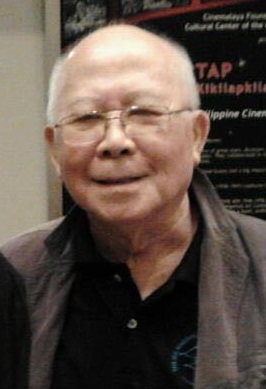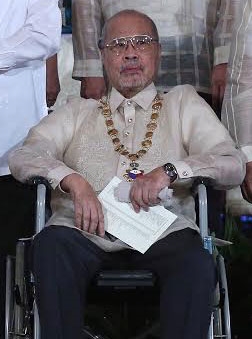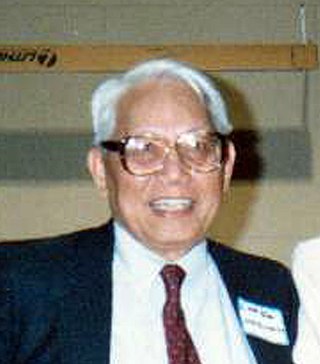
Horacio Villamayor de la Costa was a Filipino Jesuit priest, historian and academic. He was the first Filipino Provincial Superior of the Society of Jesus in the Philippines, and a recognized authority in Philippine and Asian culture and history.

Nicomedes "Nick" Marquez Joaquin was a Filipino writer and journalist best known for his short stories and novels in the English language. He also wrote using the pen name Quijano de Manila. Joaquin was conferred the rank and title of National Artist of the Philippines for Literature. He has been considered one of the most important Filipino writers, along with José Rizal and Claro M. Recto. Unlike Rizal and Recto, whose works were written in Spanish, Joaquin's major works were written in English despite being literate in Spanish.

José García Villa was a Filipino poet, literary critic, short story writer, and painter. He was awarded the National Artist of the Philippines title for literature in 1973, as well as the Guggenheim Fellowship in creative writing by Conrad Aiken. He is known to have introduced the "reversed consonance rhyme scheme" in writing poetry, as well as the extensive use of punctuation marks—especially commas, which made him known as the Comma Poet. He used the pen name Doveglion, based on the characters he derived from his own works. These animals were also explored by another poet, E. E. Cummings, in "Doveglion, Adventures in Value", a poem dedicated to Villa.
Philippine literature in English has its roots in the efforts of the United States, then engaged in a war with Filipino nationalist forces at the end of the 19th century. By 1901, public education was institutionalized in the Philippines, with English serving as the medium of instruction. That year, around 600 educators in the S.S. Thomas were tasked to replace the soldiers who had been serving as the first teachers. Outside the academe, the wide availability of reading materials, such as books and newspapers in English, helped Filipinos assimilate the language quickly. Today, 78.53% of the population can understand or speak English.

Bienvenido L. Lumbera was a Filipino poet, critic and dramatist. Lumbera is known for his nationalist writing and for his leading role in the Filipinization movement in Philippine literature in the 1960s, which resulted in his being one of the many writers and academics jailed during Ferdinand Marcos' Martial Law regime. He received the Ramon Magsaysay Award for Journalism, Literature and Creative Communications in 1993, and was proclaimed a National Artist of the Philippines for literature in 2006. As an academic, he is recognized for his key role in elevating the field of study which would become known as Philippine Studies.

Nicanor Santa Ana Abelardo was a Filipino composer known for kundiman songs he wrote before the Second World War.
Gémino Henson Abad is an educator, writer, and literary critic from Cebu, Philippines. He is a National Artist for Literature of the Philippines.

Cirilo F. Bautista was a Filipino poet, critic and writer of nonfiction. A National Artist of the Philippines award was conferred on him in 2014.

The University of the Assumption (U.A.) is a private archdiocesan Catholic university in the City of San Fernando, Pampanga, Philippines. The University of the Assumption is the first Catholic archdiocesan university in the Philippines and in Asia. It is among the top schools in the region, based on its accredited programs, and licensure and professional examination results.

Resil Buagas Mojares is a Filipino historian and critic of Philippine literature best known as for his books on Philippine history. He is acclaimed by various writers and critics as the Visayan Titan of Letters, due to his immense contribution to Visayan literature. He was recognized in 2018 as a National Artist of the Philippines for Literature - a conferment which represents the Philippine state's highest recognition for artists.

Néstor Vicente Madali González was a Filipino novelist, short story writer, essayist and, poet. Conferred as the National Artist of the Philippines for Literature in 1997.
Isagani R. Cruz is a Filipino writer and literary critic.

Virgilio Senadren Almario, better known by his pen name Rio Alma, is a Filipino author, poet, critic, translator, editor, teacher, and cultural manager. He is a National Artist of the Philippines. He formerly served as the chairman of the Komisyon sa Wikang Filipino (KWF), the government agency mandated to promote and standardize the use of the Filipino language. On January 5, 2017, Almario was also elected as the chairman of the National Commission for Culture and the Arts (NCCA).
Pura Santillan-Castrence was a Filipino writer and diplomat. Of Filipino women writers, she was among the first to gain prominence writing in the English language. She was named a Chevalier de Légion d'honneur by the French government.

Adrian E. Cristobal was a Filipino writer who frequently touched on political and historical themes. Perhaps best known to the public for his "Breakfast Table" newspaper column, he was also a Palanca Award-winning playwright, fictionist and essayist. He likewise held several positions in government during the administration of President Ferdinand E. Marcos.

José Protasio Rizal Mercado y Alonso Realonda was a Filipino nationalist, writer and polymath active at the end of the Spanish colonial period of the Philippines. He is considered a national hero of the Philippines. An ophthalmologist by profession, Rizal became a writer and a key member of the Filipino Propaganda Movement, which advocated political reforms for the colony under Spain.
Soledad Sarmiento Reyes is a Philippine literature scholar, literary and art critic, author, anthologist, consultant, professor, instructor, editor, annotator, researcher, and essayist in the Philippines. Specializing in the field of popular culture and the arts in the Philippines, Reyes is a professor teaching interdisciplinary studies at the University of the Philippines and the Ateneo de Manila University. She is an accomplished author of books and anthologies. "sa nobela mababalatuba ang mga pangyayati sa buhay ng isang kagawad sa union
Rommel Nazareno Angara is a Filipino poet and essayist. His poems saw print in Pambata, a magazine for Filipino children; Sipag Pinoy, a publication of the Department of Labor and Employment (DOLE); and Liwayway, the oldest existing Tagalog weekly magazine in the Philippines. His essays saw print in The Modern Teacher, a magazine for Filipino teachers. He is sometimes referred to as "Aurora's inspirational poet."

The Welcome Rotonda, officially Mabuhay Rotonda, is a roundabout in Quezon City in the Philippines. It is located a few meters from Quezon City's border with Manila, at the intersection of E. Rodriguez, Sr. Boulevard, Mayon Street, Quezon Avenue, Nicanor Ramirez Street, and España Boulevard. It may also refer to the monument situated on its central island.

Maria Kalaw Katigbak was a Filipina politician, journalist and beauty queen. She served as a Senator of the Philippines from 1961 to 1967 during the Fifth Congress.













